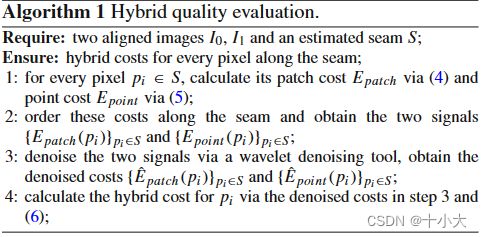【图像拼接】源码精读:Quality evaluation-based iterative seam estimation for image stitching
第一次来请先看这篇文章:【图像拼接(Image Stitching)】关于【图像拼接论文源码精读】专栏的相关说明,包含专栏内文章结构说明、源码阅读顺序、培养代码能力、如何创新等(不定期更新)
【图像拼接论文源码精读】专栏文章目录
- 【源码精读】As-Projective-As-Possible Image Stitching with Moving DLT(APAP)第一部分:全局单应Global homography
- 【图像拼接】源码精读:Seam-guided local alignment and stitching for large parallax images
文章目录
- 【图像拼接论文源码精读】专栏文章目录
- 前言
- 1. 跑通代码,得到结果
-
- 1.1 准备工作
- 1.2 尝试运行
- 1.3 得到拼接结果
- 2. 源码解读,看懂原理
-
- 2.1 准备工作
- 2.2 提取特征匹配点并对齐图像
-
- 2.2.1 总体流程
- 2.2.2 matchDelete函数
- 2.2.3 calcHomo函数
- 2.2.4 homographyAlign函数
- 2.3 迭代接缝估计,blendTexture函数
-
- 2.3.1 参数初始化
- 2.3.2 seam-cutting的准备工作
- 2.3.3 数据项、平滑项、图割
- 2.3.4 评估当前接缝(本文核心,对应论文2.2.1部分)
- 2.2.5 迭代接缝评估优化(文本核心,对应论文2.2.2部分)
- 3. 总结思考,试图创新
前言
论文题目:Quality evaluation-based iterative seam estimation for image stitching - 基于质量评估的迭代接缝估计图像拼接方法
论文链接:Quality evaluation-based iterative seam estimation for image stitching
论文源码:https://github.com/tlliao/Iterative-seam-estimation
注:matlab源码,相关算法是C++封装的。主要是对matlab的学习与理解。 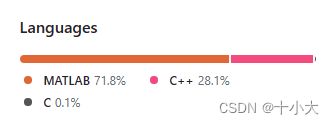
【图像拼接论文精读】专栏对应文章:【图像拼接】论文精读:Quality evaluation-based iterative seam estimation for image stitching
配合对应的文章阅读,效果更佳!
注:请重点关注代码段中的注释!!!有一些讲解的东西直接写在代码段的注释中了,同时多关注红色字体和绿色字体!!!
1. 跑通代码,得到结果
任何源码下载下来后,第一件事就是先跑通。
无论你是否要在该工作的基础上创新,总是需要得到拼接结果,在论文的实验部分做对比。
所以,请务必跑通,得到拼接结果。
1.1 准备工作
本地需要matlab环境,我是MATLAB R2018b,选择一个适中的matlab版本即可。(最新的matlab2023可以使用局部函数了,类似jupyter notebook,感兴趣的同学可以试试最新版。)
源码下载下来后,用matlab打开项目,界面如下:
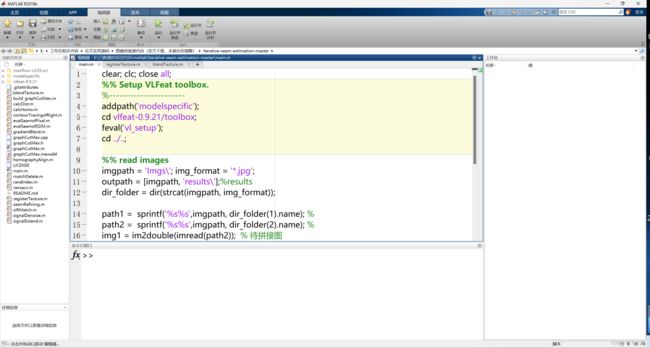
左侧是文件目录结构,中级是当前所选文件代码,下面是命令行窗口,右侧是工作区(运行后显示相关变量的值)
1.2 尝试运行
点击上面菜单栏【运行】,出现如下报错:

检查后发现,当前目录下为vlfeat-0.9.21文件夹,而不是vlfeat-0.9.20。修改为:
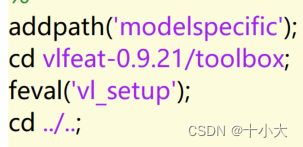
并将其他源码中的vlfeat-0.9.21文件夹复制过来。初始下载的源码中vlfeat-0.9.21为空。
如果在其他论文源码中找不到可用的vlfeat-0.9.21,则可以直接点击下面的链接下载。
vlfeat-0.9.21下载链接(已经配置好,复制到源码目录下可以直接使用):图像拼接论文源码matlab所需的vlfeat-0.9.21库,已经配置好,复制到源码目录下即可直接使用
除此之外,文件目录下还缺少Imgs文件夹。将其添加,这里以temple数据集为例,目录变为下图所示:

此时运行代码,已经可以完整的跑通了。
1.3 得到拼接结果
跑通的命令行显示与拼接结果:
这里我互换了参照图和目标图,让右图为目标图。
2. 源码解读,看懂原理
本节将按照main.m中的代码顺序进行【模块化】讲解,包括与论文中的算法对应、matlab语法和函数学习、变量的类型和值、函数功能等方面。代码段中包含原作者的注释和我做的注释,与讲解结合着阅读。
2.1 准备工作
代码如下:
clear; clc; close all;
%% Setup VLFeat toolbox.
%----------------------
addpath('modelspecific');
cd vlfeat-0.9.21/toolbox;
feval('vl_setup');
cd ../..;
%% read images
imgpath = 'Imgs\'; img_format = '*.jpg';
outpath = [imgpath, 'results\'];%results
dir_folder = dir(strcat(imgpath, img_format));
path1 = sprintf('%s%s',imgpath, dir_folder(1).name); %
path2 = sprintf('%s%s',imgpath, dir_folder(2).name); %
img1 = im2double(imread(path2)); % 待拼接图
img2 = im2double(imread(path1)); % 基准图
代码包含重复运行的清空操作,设置vlfeat库,读取Imgs文件夹下的输入图像,得到两张输入图像img1和img2。这里我们将参照图和目标图互换,右图为目标图,符合其他论文将右图作为目标图的习惯。
2.2 提取特征匹配点并对齐图像
代码如下:
%% detect features and align images
fprintf('> feature matching and image alignment...');tic;
[warped_img1, warped_img2] = registerTexture(img1, img2);
fprintf('done (%fs)\n', toc);
registerTexture函数:
function [warped_img1, warped_img2] = registerTexture(img1, img2)
% given two images, detect sift feature matches and calculate the homography warp
% img1: target image to be warped
% img2: reference image
% warped_img1: warped img1
% warped_img2: warped img2
[pts1, pts2] = siftMatch(img1, img2); % sift feature matches
Sz1 = max(size(img1,1),size(img2,1)); % to avoid the two images have different size
Sz2 = max(size(img1,2),size(img2,2));
[matches_1, matches_2] = matchDelete(pts1, pts2, Sz1, Sz2); % delete wrong match features (outliers)
init_H = calcHomo(matches_1, matches_2); % fundamental homography
[warped_img1, warped_img2] = homographyAlign(img1,img2,init_H); % warped images via homography warp
end
2.2.1 总体流程
首先,sift提取到特征点(siftMatch.m),特征点pts1和pts2是2×n的非齐次格式,如果两张图像不一样大,则取最大的作为宽(Sz1)高(Sz2)。然后,筛选匹配点(matchDelete.m)得到正确匹配matches_1和matches_2,进而根据正确匹配点得到单应矩阵H(calcHomo.m)。最后,根据H对齐两张图像(homographyAlign.m),得到翘曲后的两张图像warped_img1和warped_img2。
2.2.2 matchDelete函数
- 函数功能:剔除异常值,分为【剔除重复值】、【直方图剔除离群值】和【RANSAC剔除异常值】三步。
- 参数:pts1, pts2, height, width分别为SIFT得到的两组非齐次匹配点,图像的高、宽
- 返回值:matches1, matches2剔除异常值后的正确匹配点
剔除重复值:
%% delete the wrong matches (one-to-more)
[~, ind_1] = unique(pts1', 'rows'); % pts1变成n*2,找唯一的行,返回n*1的索引
pts1 = pts1(:,ind_1'); % 保留索引,剔除重复的
pts2 = pts2(:,ind_1');
[~, ind_2] = unique(pts2', 'rows'); % 从pst2中再剔除重复的
pts1 = pts1(:,ind_2');
pts2 = pts2(:,ind_2');
直方图剔除离群值:
%% use histogram (horizontal and vertical orientation) delete outliers
% 直方图剔除异常值
thr = 0.1; % 划分范围,1/10,-10~+10,宽是730,则xbins间距就是73
% horizontal histogram
xbins = (-width+width*thr/2:width*thr:width-width*thr/2); % 横坐标列表
counts1 = hist(pts1(1,:)-pts2(1,:), xbins); % 横坐标插值的直方图,个数
[~,ia1] = max(counts1); % 直方图峰值索引
% 筛选出有效范围内的横坐标插值索引(>=的是下界,<=的是上界)
% 要与最大索引所在段的相邻两段,比如ia1=7,就是要第6,7,8三段内的点
C1 = find(pts1(1,:)-pts2(1,:)>=max(-width,-width+(ia1-2)*width*thr) & pts1(1,:)-pts2(1,:)<=min(width,-width+(ia1+1)*width*thr));
% vertical histogram
ybins = (-height+height*thr/2: height*thr: height-height*thr/2);
counts2 = hist(pts1(2,:)-pts2(2,:), ybins);
[~, ia2] = max(counts2);
C2 = find(pts1(2,:)-pts2(2,:)>=max(-height,-height+(ia2-2)*height*thr) & pts1(2,:)-pts2(2,:)<=min(height, -height+(ia2+1)*height*thr));
% final inliers after 1st filter
C = intersect(C1,C2); % 交集
pts1 = pts1(:,C);
pts2 = pts2(:,C);
首先根据阈值thr划分间距范围,得到横纵坐标的列表,然后根据两组匹配点的差值画出直方图:
水平方向(横坐标):
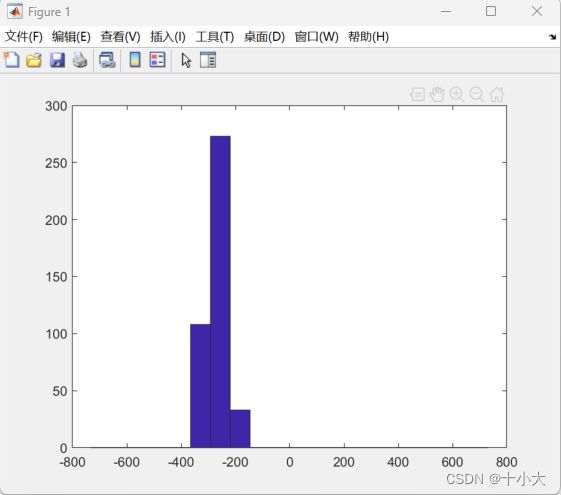
纵坐标方向:

以水平方向为例,count1的统计结果如下:
最多的点分布在第七段(ia1=7),筛选条件就是得到最大段相邻的两段,即本例中的6、7、8段,其他段内的点视为离群点。
RANSAC剔除异常值:
%% RANSAC delete
fprintf('> do RANSAC feature filter...\n');tic;
coef.minPtNum = max(min(round(size(pts1,2)/4),10),4);
coef.iterNum = 1000;
coef.thDist = 5;
coef.thInlrRatio = .1;
[~,corrPtIdx1] = ransacx(pts1, pts2, coef);
matches1 = pts1(:, corrPtIdx1);
matches2 = pts2(:, corrPtIdx1);
其中,ransacx函数是执行ransac过程,找到内点最多的模型
function [f,inlierIdx] = ransacx( x,y, ransacCoef )%, funcFindF, funcDist)
% 函数功能:使用RANSAC,找到从x到y的拟合
% x,y:n个点的矩阵,维数×n。本例就是2×n
% ransacCoef:参数结构体,包含四个字段minPtNum,iterNum,thDist,thInlrRatio,其中
% minPtNum:找到拟合点的最小点数,直线拟合是2,单应是4
% iterNum:迭代次数
% thDist:离群点距离阈值
% thInlrRatio:内点阈值比例
% f,inlierIdx:返回拟合结果和内点索引
minPtNum = ransacCoef.minPtNum;
iterNum = ransacCoef.iterNum;
thInlrRatio = ransacCoef.thInlrRatio;
thDist = ransacCoef.thDist;
ptNum = size(x,2);
thInlr = round(thInlrRatio*ptNum); % 内点数量阈值
inlrNum = zeros(1,iterNum);
fLib = cell(1,iterNum);
% 执行RANSAC过程
% 1. 随机选择minPtNum个点,计算单应变换
% 2. 计算选择的点到模型的距离,找到符合阈值条件thDist的内点inlier1
% 3. 如果内点数小于thInlr,则继续迭代
% 4. 选择内点最多的模型索引 idx 和数量 max_inlier
% 如果最大内点数量为零,则返回空值。
% 否则,使用具有最大内点数量的模型重新计算几何模型 f,并标识出距离模型距离小于 thDist 的内点索引 inlierIdx
parfor p = 1:iterNum
% 1. fit using random points
sampleIdx = randIndex(ptNum,minPtNum);
f1 = calcHomo(x(:,sampleIdx),y(:,sampleIdx));%funcFindF(x(:,sampleIdx),y(:,sampleIdx)); % For homography: f1 is H
% 2. count the inliers, if more than thInlr, refit; else iterate
dist = calcDist(f1,x,y);%funcDist(f1,x,y);
inlier1 = find(dist < thDist); %caculate count of inlier
if length(inlier1) < thInlr, continue; end
inlrNum(p) = length(inlier1);
fLib{p} = inlier1; % re-caculate H
end
% 3. choose the coef with the most inliers
[max_inlier, idx] = max(inlrNum);
if max_inlier==0
inlierIdx = [];
f = [];
return;
end
f = calcHomo(x(:,fLib{idx}),y(:,fLib{idx})); %most inliers
dist = calcDist(f,x,y); % find match point
inlierIdx = find(dist < thDist);
f = calcHomo(x(:,inlierIdx),y(:,inlierIdx));
end
RANSAC过程更多的细节可以查看图像拼接】源码精读:Seam-guided local alignment and stitching for large parallax images的章节2.2.3。
至此,内点inliers已经筛选完毕。
2.2.3 calcHomo函数
函数功能:根据inliers计算单应矩阵
function H = calcHomo(pts1,pts2)
%% use Direct linear tranformation (DLT) to calculate homography
% approxmation: H*[pts1; ones(1,size(pts1,2))] = [pts2; ones(1,size(pts2,2))]
% Normalise point distribution.
data_pts = [ pts1; ones(1,size(pts1,2)) ; pts2; ones(1,size(pts2,2)) ];
[ dat_norm_pts1,T1 ] = normalise2dpts(data_pts(1:3,:));
[ dat_norm_pts2,T2 ] = normalise2dpts(data_pts(4:6,:));
data_norm = [ dat_norm_pts1 ; dat_norm_pts2 ];
%-----------------------
% Global homography (H).
%-----------------------
%fprintf('DLT (projective transform) on inliers\n');
% Refine homography using DLT on inliers.
%fprintf('> Refining homography (H) using DLT...');
[ h,~,~,~ ] = feval('homography_fit',data_norm);
H = T2\(reshape(h,3,3)*T1);
end
这里不过多赘述,与APAP中的代码基本一致。链接:【源码精读】As-Projective-As-Possible Image Stitching with Moving DLT(APAP)第一部分:全局单应Global homography
2.2.4 homographyAlign函数
函数功能:根据单应矩阵得到翘曲后的两张图像。
此处代码略,可以查看图像拼接】源码精读:Seam-guided local alignment and stitching for large parallax images的章节2.2.5。
2.3 迭代接缝估计,blendTexture函数
2.3.3对应论文的2.1部分Conventional seam-cutting,是Perception-based-seam-cutting论文中基于感知的接缝算法得到的初始接缝,通过数据项和平滑项,经过图割和梯度融合得到拼接结果。
2.3.4对应论文的2.2.1 Hybrid quality evaluation和算法1,提出接缝上像素点和像素块的混合质量评估,通过小波去噪平滑信号。对应图2的展示,单独像素点成本和去噪成本、单独的像素块成本和去噪成本、点、块去噪成本和混合成本,可以看到混合的成本更低。
2.3.5对应论文的2.2.2 Seam estimation refinement和算法2,迭代优化接缝评估,根据混合评估更新差异图,错位的地方惩罚加重,两侧扩展5像素。根据新的差异图重新计算能量函数,不停地迭代更新,直到达到合理范围(差异的点少于10个,这个参数可以修改)。
main.m中的代码如下:
%% iterative seam estimation
fprintf('> seam estimation and image blending...');tic;
blendTexture(warped_img1, warped_img2);
fprintf('done (%fs)\n', toc);
本节我们将一段一段讲解blendTexture.m文件下对应的代码,也是本论文的核心。
2.3.1 参数初始化
代码如下:
%% preparation: parameter initialization
patchsize = 21; % the size of patch for seam evaluation
max_iterations = 1000; % maximum iterations for seam estimation
gray1 = rgb2gray(warped_img1); gray2 = rgb2gray(warped_img2);
square_SE = strel('square', 2);
signal_mu = 0.12; %parameters for f(x)=exp(sigma_ratio*(x-mu)) 论文中公式(7)
sigma_ratio = 5;
设置了20×20大小的块,迭代最大次数为1000,论文中公式(7)对应的参数。
2.3.2 seam-cutting的准备工作
代码如下:
%% pre-process of seam-cutting
w1 = imfill(imbinarize(gray1, 0),'holes');
w2 = imfill(imbinarize(gray2, 0),'holes');
A = w1; B = w2;
C = A & B; % overlapping region
[sz1, sz2] = size(C);
ind = find(C); % 重叠区域非零元素索引
nNodes = size(ind,1); % 非零像素个数
revindC = zeros(sz1*sz2,1);
revindC(C)=1:length(ind);
[tmp_y, tmp_x] = find(B==1);
% 目标图坐标范围,因为我们将参照图和目标图互换了
B_x0 = tmp_x(1); B_y0 = tmp_y(1); % begining coordinates of reference in final canvas
B_x1 = tmp_x(end); B_y1 = tmp_y(end); % ending coordinates of reference in final canvas
gray_cut1 = gray1(B_y0:B_y1,B_x0:B_x1); % 灰色目标图
gray_cut2 = gray2(B_y0:B_y1,B_x0:B_x1); % 灰色参照图
C_cut = C(B_y0:B_y1,B_x0:B_x1); % 目标图中重叠区域掩码
gray_cut1 、gray_cut2、C_cut的可视化如下:
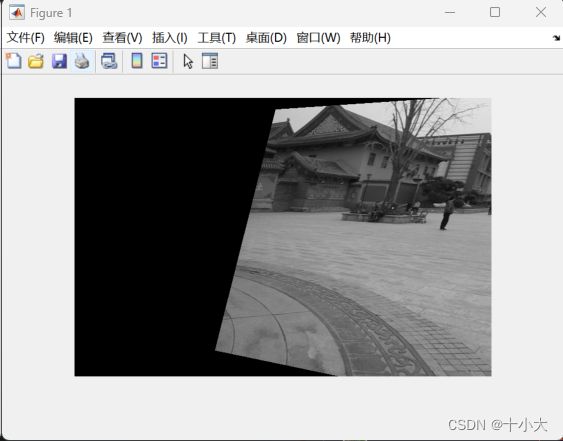
2.3.3 数据项、平滑项、图割
代码略。详细请见文章【图像拼接】源码精读:Seam-guided local alignment and stitching for large parallax images的2.3.1、2.3.3、2.2.4部分。
与Seam-guided local alignment and stitching for large parallax images中不同,本文方法的平滑项用的是欧式准则,而Seam-guided local alignment and stitching for large parallax images用的sigmoid。
2.3.4 评估当前接缝(本文核心,对应论文2.2.1部分)
本节对应论文中2.2.1 Hybrid quality evaluation与算法1,和部分2.2.2 Seam estimation refinement的内容。
代码段如下:
%% evaluate the current stitching seam
B_contour = Bs(B_y0:B_y1,B_x0:B_x1); % 轮廓,值为1是原目标图,值为0是翘曲后的部分,1和0分界的地方是接缝
[hybrid_signal, boundarypts] = seamRefining(gray_cut1, gray_cut2, imgdif_cut, C_cut, B_contour, patchsize);
Boundpts = boundarypts + repmat([B_y0-1,B_x0-1],length(boundarypts),1); % 全尺寸下缝合线坐标
[extend_signal, extendpts] = signalExtend(hybrid_signal, Boundpts, As, Bs, C); % 扩展区域,每侧扩充5像素。
function [ hybrid_signal, boundarypts ] = seamRefining( gray1, gray2, imgdif, C, B_contour, patchsize)
% given seam information, calculate the patch/pixel signals and denoised
% hybrid signal, return the output signal and extend seam points
% 接缝优化
% gray1 和 gray2:两个灰度图像。
% imgdif:图像差异信息。
% C:重叠区域的二值图像。
% B_contour:轮廓信息。
% patchsize:补丁(patch)的大小。
B_seam = B_contour;
if sum(B_seam(1:end, 1))==size(B_seam,1) % 检查第一列如果全是1,则参照图在左边,取反
B_seam = ~B_seam; %% to find out the reference is on the left or right
B_seam = imdilate(imerode(B_seam, strel('square', 2)), strel('square', 2)); % 腐蚀膨胀
else
B_seam = imdilate(imerode(B_seam, strel('square', 2)), strel('square', 2));
end
% 检查 B_seam 的第一列和第一行是否全为零,以确定是否需要对 B_seam 进行旋转。
if sum(B_seam(1:end,1)) + sum(B_seam(1,1:end))==0
rotate_B_seam = B_seam(1+size(B_seam,1)-1:-1:1+size(B_seam,1)-end, 1+size(B_seam,2)-1:-1:1+size(B_seam,2)-end);
boundarypts = contourTracingofRight(~rotate_B_seam);
boundarypts = [1+size(B_seam,1)-boundarypts(:,1), 1+size(B_seam,2)-boundarypts(:,2)];
else
boundarypts = contourTracingofRight(B_seam); % 找到接缝边界,n×2
end
patch_signal = evalSeamofSSIM(gray1, gray2, C, boundarypts, patchsize); % patch signal
pixel_signal = evalSeamofPixel(imgdif, B_seam, boundarypts); % pixel signal
denoise_patch_signal = signalDenoise(patch_signal); % denoise patch signal
denoise_pixel_signal = signalDenoise(pixel_signal); % denoise pixel signal
hybrid_signal = 10.*denoise_patch_signal.*denoise_pixel_signal; % hybrid signal
end
首先找到拼接缝的像素点坐标(考虑参照图在左还是在右,是否旋转过),对接缝上每个像素点,定义一个块(20×20),计算这个局部块的SSIM。如果SSIM为1,则认为两个块相同,不需要优化。将像素块和像素点作为一个混合的去噪成本,后续优化它。定义为论文中的公式(6):

通过源码我们得知, λ = 10 \lambda = 10 λ=10。
关于去噪方式:作者尝试过高斯滤波平滑和小波平滑,最后发现小波去噪更有效。
2.2.5 迭代接缝评估优化(文本核心,对应论文2.2.2部分)
按公式(7)修改接缝上未对齐接缝像素的成本:
%% 2nd-iteration for further refinement
% calculate a new stitching seam
imgdif2 = imgdif; ind_seam = (extendpts(:,2)-1)*sz1 + extendpts(:,1);
imgdif2(ind_seam) = imgdif2(ind_seam).*(exp(sigma_ratio.*(extend_signal-signal_mu))); %公式(7)
DL = (imgdif2(CL1) + imgdif2(CL2))./2;
DU = (imgdif2(CU1) + imgdif2(CU2))./2;
edgeWeights2=[
revindC(CL1) revindC(CL2) DL+1e-8 DL+1e-8;
revindC(CU1) revindC(CU2) DU+1e-8 DU+1e-8
];
%% graph cut optimization
[~, labels2] = graphCutMex(terminalWeights, edgeWeights2);
As=A; Bs=B;
As(ind(labels2==1))=false;
Bs(ind(labels2==0))=false;
final_As = As;
注:如果你先看了Seam-guided local alignment and stitching for large parallax images,就会发现,本文的公式(7)已经变成sigmoid了。
接缝两侧扩展5个像素生成块,设置新的混合成本,差分图重新计算,用新的差分图重新计算能量函数,迭代平滑项:
%% evaluate the current stitching seam
B_contour = Bs(B_y0:B_y1,B_x0:B_x1);
[hybrid_signal2, boundarypts2] = seamRefining(gray_cut1, gray_cut2, imgdif_cut, C_cut, B_contour, patchsize);
Boundpts2 = boundarypts2 + repmat([B_y0-1,B_x0-1], length(boundarypts2),1); % 全尺寸下缝合线坐标
[extend_signal2, extendpts2] = signalExtend(hybrid_signal2, Boundpts2, As, Bs, C);
%% iteration (while-loop) for seam refining
end_seam = union(extendpts, extendpts2, 'rows'); % 扩展接缝
overlap_pts = setdiff(Boundpts2, extendpts, 'rows'); % 差集
k_seam = 3;
% 扩展前后的点大于10个并且迭代次数小于设置的最大迭代次数时,继续迭代
% 1. 根据当前的接缝扩展点extendpts2来更新平滑项
% 2. 图割得到新的接缝结果
% 3. 最后更新迭代次数、扩展点集、扩展信号集、差异图
while length(overlap_pts)>10 && k_seam<=max_iterations % change exceed 10 pixels
ind_seam2 = (extendpts2(:,2)-1)*sz1 + extendpts2(:,1);
imgdif3 = imgdif2;
imgdif3(ind_seam2) = imgdif3(ind_seam2).*(exp(sigma_ratio.*(extend_signal2-signal_mu)));
DL = (imgdif3(CL1) + imgdif3(CL2))./2;
DU = (imgdif3(CU1) + imgdif3(CU2))./2;
edgeWeights3=[
revindC(CL1) revindC(CL2) DL+1e-8 DL+1e-8;
revindC(CU1) revindC(CU2) DU+1e-8 DU+1e-8
];
%% graph cut optimization
[~, labels3] = graphCutMex(terminalWeights, edgeWeights3);
As=A; Bs=B;
As(ind(labels3==1))=false;
Bs(ind(labels3==0))=false;
final_As = As;
%% evaluate the current stitching seam
B_contour = Bs(B_y0:B_y1,B_x0:B_x1);
[hybrid_signal3, boundarypts3] = seamRefining(gray_cut1, gray_cut2, imgdif_cut, C_cut, B_contour, patchsize);
Boundpts3 = boundarypts3 + repmat([B_y0-1,B_x0-1],length(boundarypts3),1); % 全尺寸下缝合线坐标
[extend_signal3, extendpts3] = signalExtend(hybrid_signal3, Boundpts3, As, Bs, C);
overlap_pts = setdiff(Boundpts3, end_seam, 'rows');
end_seam = union(end_seam, extendpts3, 'rows');
k_seam = k_seam + 1;
extendpts2 = extendpts3;
extend_signal2 = extend_signal3;
imgdif2 = imgdif3;
end
可视化:
% 可视化迭代过程
final_out = gradientBlend(warped_img1, final_As, warped_img2);
final_Bs = (A|B) & ~final_As;
C_seam = imdilate(final_As, square_SE) & imdilate(final_Bs, square_SE) & C;
final_seam = final_out;
final_seam(cat(3, C_seam, C_seam, C_seam)) = [ones(sum(C_seam(:)),1); zeros(2*sum(C_seam(:)),1)];
fprintf('final output comes from k_seam = %d\n', k_seam-1);
figure,imshow(final_out);
figure,imshow(final_seam);
%outpath = sprintf('%d-final_out.jpg',k_seam-1)
%imwrite(final_out, outpath)
%outpath1 = sprintf('%d-final_seam.jpg',k_seam-1)
%imwrite(final_seam, outpath1)
如果将可视化部分的代码段写在循环内,则可以观察到接缝变化的过程。这里我们用temple数据集试着展示图3中的接缝变化过程,用红色表示接缝。
( a ) Initial iteration:
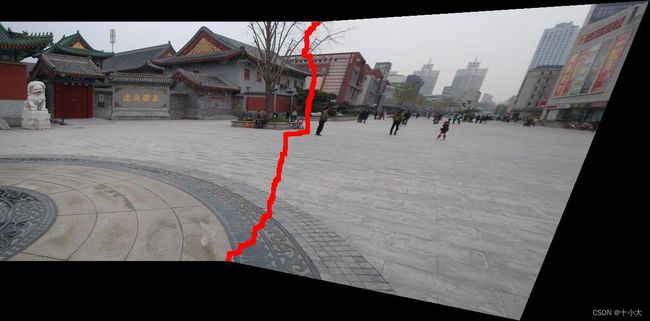
|
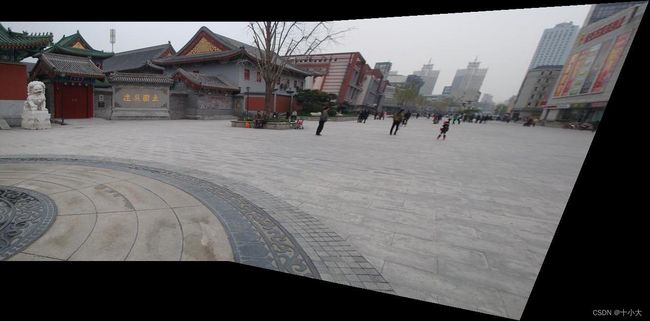
|
( b ) Middle iteration:

|
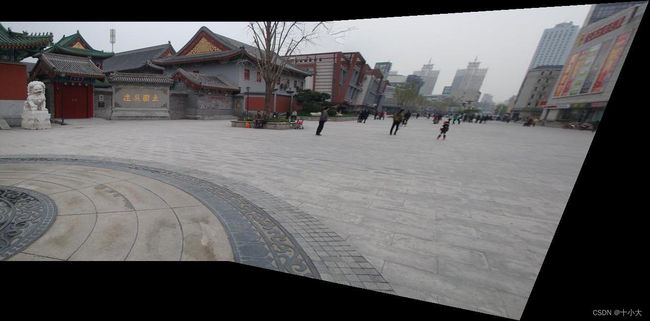
|
( c ) Latter iteration:

|

|
( d ) Final result:

|

|
至此,本文的代码已解读完毕。
3. 总结思考,试图创新
- 迭代接缝估计算法,校正错位的接缝
- 质量评估算法能得到错位的地方,能为后续的接缝方法提供接缝评估手段
PS:已经在后文Seam-guided local alignment and stitching for large parallax images中做到了。
- 对每个接缝上的像素,计算像素点成本和块成本
- 得到上面两个的信号值
- 小波去噪平滑信号,得到两个去噪后的成本
- 计算去噪后的混合成本
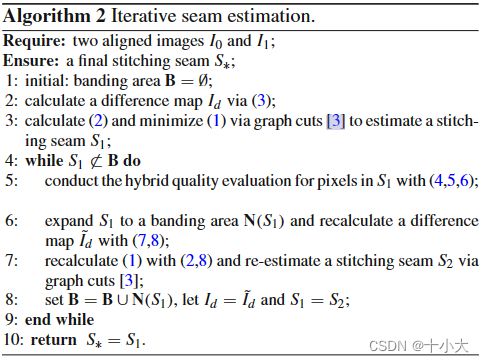
算法2: - 初始化区域(两边各扩展5像素)
- 计算差异图
- 图割计算接缝
- 不满足条件时
- 扩展像素、重新计算差异图、图割得到新的接缝,重复这三步,直到跳出循环
拼接结果对比展示:
初始接缝拼接结果:

本文算法的结果:

可以看到,初始的接缝破坏了原有的结构(树),而本文的算法经过迭代优化接缝,得到了比较不错的效果。
本文的创新已在【图像拼接】源码精读:Seam-guided local alignment and stitching for large parallax images中实现。
感谢同学们阅读本文,如果对你有所帮助,点个赞,点个收藏吧,我们下一篇论文源码精读再会!





